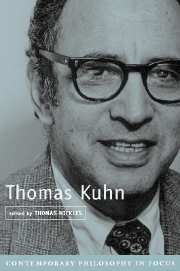Book contents
- Frontmatter
- Contents
- Contributors
- Preface
- Introduction
- 1 Kuhn and Logical Empiricism
- 2 Thomas Kuhn and French Philosophy of Science
- 3 Normal Science and Dogmatism, Paradigms and Progress: Kuhn ‘versus’ Popper and Lakatos
- 4 Kuhn's Philosophy of Scientific Practice
- 5 Thomas Kuhn and the Problem of Social Order in Science
- 6 Normal Science: From Logic to Case-Based and Model-Based Reasoning
- 7 Kuhn, Conceptual Change, and Cognitive Science
- 8 Kuhn on Concepts and Categorization
- 9 Kuhn's World Changes
- 10 Does The Structure of Scientific Revolutions Permit a Feminist Revolution in Science?
- Selected References in English
- Index
- References
9 - Kuhn's World Changes
Published online by Cambridge University Press: 07 December 2009
- Frontmatter
- Contents
- Contributors
- Preface
- Introduction
- 1 Kuhn and Logical Empiricism
- 2 Thomas Kuhn and French Philosophy of Science
- 3 Normal Science and Dogmatism, Paradigms and Progress: Kuhn ‘versus’ Popper and Lakatos
- 4 Kuhn's Philosophy of Scientific Practice
- 5 Thomas Kuhn and the Problem of Social Order in Science
- 6 Normal Science: From Logic to Case-Based and Model-Based Reasoning
- 7 Kuhn, Conceptual Change, and Cognitive Science
- 8 Kuhn on Concepts and Categorization
- 9 Kuhn's World Changes
- 10 Does The Structure of Scientific Revolutions Permit a Feminist Revolution in Science?
- Selected References in English
- Index
- References
Summary
Of all the controversial elements of The Structure of Scientific Revolutions (1962/1970), the most controversial and problematic for the majority of readers are Kuhn's claims about the changes in the world that accompany scientific revolutions. Kuhn's own ambivalence about his doctrine is exemplified by the contrast between the title of Chapter X, “Revolutions as Changes of World View,” which places the changes in the minds and theories of the scientists, and the first sentence of that section, which shows the temptation to locate the change in the worlds themselves:
Examining the record of past research from the vantage of contemporary historiography, the historian of science may be tempted to exclaim that when paradigms change, the world itself changes with it.
(1970 ed., p. 111)Kuhn describes himself as “acutely aware” of the difficulties posed by his locutions:
The same difficulties are presented in an even more fundamental form by the opening sentences of this section: though the world does not change with a change of paradigm, the scientist afterward works in a different world.
(p. 121)One example he discusses at some length (pun intended) is the pendulum. Heavy objects suspended by ropes or chains had existed for a long time, and certainly their occasional motions had been observed. However, for an Aristotelian this is an example of unnatural motion: The heavy body is moved by its nature toward the center of the Earth and the universe, but it is constrained by the suspension.
- Type
- Chapter
- Information
- Thomas Kuhn , pp. 246 - 260Publisher: Cambridge University PressPrint publication year: 2002



